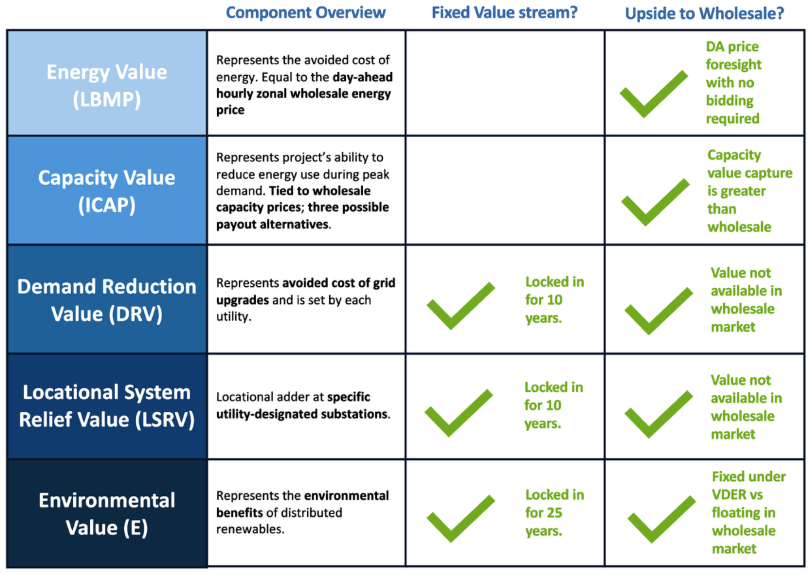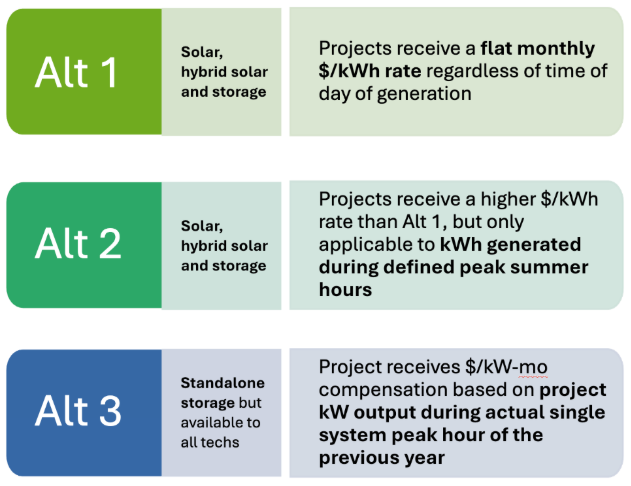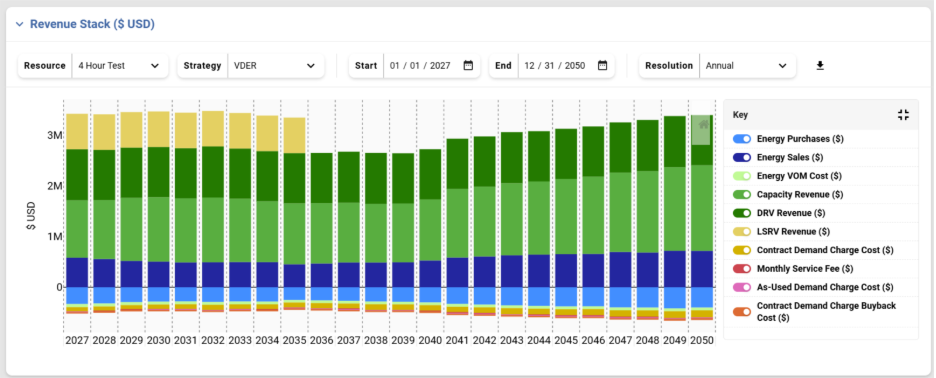
Let's Connect
Contact us
Thank you for reaching out, we will be in touch shortly!
Oops! Something went wrong while submitting the form.


New York's Value of Distributed Energy Resources (VDER) compensation mechanism serves as a valuable alternative to the New York Independent System Operator (NYISO) wholesale market. By compensating distributed energy resources such as solar or batteries based on when and where they provide electricity to the grid, VDER's unique 'Value Stack' structure provides higher returns and lower uncertainty for energy project developers. VDER also helps reduce energy costs for consumers who subscribe to distributed generation projects.
The VDER tariff has been instrumental in helping New York to meet policy goals related to distributed resource growth, particularly for community solar: more than 2 GW of community solar projects have been installed using the VDER compensation tariff, making New York a national leader in community solar deployment.
VDER is a tariff that uses a 'Value Stack' structure to compensate distributed energy generation resources, such as community solar or storage, based on avoided costs. The VDER mechanism was established in 2017 by the New York State Public Service Commission to incentivize distributed renewable generation development, particularly community solar.
VDER was developed as an alternative to traditional distributed energy resource (DER) compensation tariffs that are tied to the retail rate of electricity.
Instead, the VDER Value Stack, which is closely tied to the wholesale market, compensates resources based on when and where they provide electricity to the grid, accounting for time of day and location of resource generation. VDER compensation is meant to reflect the actual benefits that a resource provides to New York’s electric grid.
The VDER mechanism supports the development and interconnection of distributed generation projects throughout New York. The process of DER development begins when an energy project developer creates a small (5 MW or less) renewable project, such as solar, storage, or hybrid, then connects it to the local utility grid. Developers are responsible for finding subscribers – who are also utility ratepayers – that will pay a monthly fee to receive shares of the project’s energy, which ultimately result in credits that reduce a subscriber's monthly energy bill.
The generated energy then feeds into the grid, after which the utility determines the value of the energy created using the VDER Value Stack methodology. Then, the utility allocates the monetary credit of the energy produced to a subscriber's bill.
The VDER Value Stack is designed to replace retail-rate tariffs with a value-based system. As shown in Figure 1, the Value Stack includes five components in which developers are paid according to the benefits their projects produce for the grid. This approach offers more stable revenue and better capacity value than that offered by wholesale markets.

Each component of the VDER value stack provides revenue generating opportunities for energy project developers.
The Energy Value component is equivalent to the hourly day-ahead Locational-Based Marginal Price (LBMP) for a relevant NYISO Zone. Hourly pricing creates energy arbitrage opportunities for both hybrid and standalone storage.
The Capacity Value (ICAP) is tied to wholesale capacity prices and is paid out under one of three alternatives, as shown in Figure 2. Significantly, hybrid projects that dispatch full capacity during the Alt 2 window, and standalone projects that dispatch full capacity during the single Alt 3 peak hour, receive full capacity accreditation – which represents an enormous opportunity for storage. Unlike the wholesale market, storage is not subject to effective load carrying capability (ELCC) deration, which means increased capacity revenue potential in VDER.

The Demand Reduction Value (DRV) and Locational System Relief Value (LSRV) components provide added value for projects in grid-constrained areas. Both lock in rates for 10 years, thus providing a measure of certainty for energy project developers.
The Environmental Value component guarantees a source of revenue for eligible distributed generation projects. Essentially a fixed REC available to solar projects and hybrid projects that charge from solar (though not to grid-charging storage), it is paid out per kWh of generation and is fixed for 25 years.
Maximizing value with VDER requires developers to consider several important factors, including zonal LBMP, zonal capacity prices, utility-specific DRV, substation-specific LSRV, and charging costs.
Much like in wholesale energy project development, siting is also crucial for ensuring a successful VDER project. Doing so often proves complicated, however. Developers must find a site that possesses, among other factors, sound fundamental economics, available interconnection/distribution hosting capacity, and affordable/buildable land. Ascend's PowerVAL platform serves as a powerful asset in optimizing siting decisions: users have access to Market Intelligence Maps, which help developers quickly identify a subset of suitable potential project locations.
The terms "VDER Calculator" or "Value Stack Calculator" generally describe a tool offered by the New York State Energy Research and Development Authority (NYSERDA) to help project developers estimate potential project compensation.
The Ascend PowerVAL platform offers a much more comprehensive way to assess distributed energy generation projects in New York. Through Ascend's Asset Valuation tool specifically designed for VDER, PowerVAL users can model solar, storage hybrid, and standalone storage projects. Users can customize project configuration, bidding strategy and foresight, VDER compensation values (energy, capacity, DRV, and LSRV), and charging costs (supply, demand, as-used demand, and flat-rate charges). As shown in Figure 3, study outputs display project margins, charging costs, and revenues by VDER stack component. The VDER Asset Valuation tool is available for subscribers in the PowerVAL platform.

By reflecting real world dynamics and with a more sophisticated optimization, the Ascend approach values project margins around 40% higher relative to tools such as the NYSERDA VDER calculator.
Ascend's PowerVAL energy analytics platform can help developers fully capture value through VDER. Ascend provides energy and capacity price forecasts grounded in market fundamentals, hourly granularity with regard to charging costs, and an accurate view of hourly system dispatch between retail charging costs and VDER revenue.
Ascend's VDER forecasts include pricing dynamics and project revenue, informed by long-term wholesale market fundamentals such as load growth, changes in the supply stack, fuel prices, and policy drivers. Geospatial mapping includes distribution hosting capacity, interconnection queues, land parcel data, substation and power plant locations, and transmission.
Trusted across hundreds of deals and more than $1B in transaction value, PowerVALTM provides bankable revenue forecasts and nodal-specific valuations for storage, renewables, and hybrid projects under multiple operating strategies across all ISOs.
Contact us to learn more, or access Ascend's latest VDER webinar to gain VDER-related revenue outlooks, as well as analyses of challenges and opportunities for solar, storage, and hybrid battery systems.

New York's Value of Distributed Energy Resources (VDER) compensation mechanism serves as a valuable alternative to the New York Independent System Operator (NYISO) wholesale market. By compensating distributed energy resources such as solar or batteries based on when and where they provide electricity to the grid, VDER's unique 'Value Stack' structure provides higher returns and lower uncertainty for energy project developers. VDER also helps reduce energy costs for consumers who subscribe to distributed generation projects.
The VDER tariff has been instrumental in helping New York to meet policy goals related to distributed resource growth, particularly for community solar: more than 2 GW of community solar projects have been installed using the VDER compensation tariff, making New York a national leader in community solar deployment.
VDER is a tariff that uses a 'Value Stack' structure to compensate distributed energy generation resources, such as community solar or storage, based on avoided costs. The VDER mechanism was established in 2017 by the New York State Public Service Commission to incentivize distributed renewable generation development, particularly community solar.
VDER was developed as an alternative to traditional distributed energy resource (DER) compensation tariffs that are tied to the retail rate of electricity.
Instead, the VDER Value Stack, which is closely tied to the wholesale market, compensates resources based on when and where they provide electricity to the grid, accounting for time of day and location of resource generation. VDER compensation is meant to reflect the actual benefits that a resource provides to New York’s electric grid.
The VDER mechanism supports the development and interconnection of distributed generation projects throughout New York. The process of DER development begins when an energy project developer creates a small (5 MW or less) renewable project, such as solar, storage, or hybrid, then connects it to the local utility grid. Developers are responsible for finding subscribers – who are also utility ratepayers – that will pay a monthly fee to receive shares of the project’s energy, which ultimately result in credits that reduce a subscriber's monthly energy bill.
The generated energy then feeds into the grid, after which the utility determines the value of the energy created using the VDER Value Stack methodology. Then, the utility allocates the monetary credit of the energy produced to a subscriber's bill.
The VDER Value Stack is designed to replace retail-rate tariffs with a value-based system. As shown in Figure 1, the Value Stack includes five components in which developers are paid according to the benefits their projects produce for the grid. This approach offers more stable revenue and better capacity value than that offered by wholesale markets.

Each component of the VDER value stack provides revenue generating opportunities for energy project developers.
The Energy Value component is equivalent to the hourly day-ahead Locational-Based Marginal Price (LBMP) for a relevant NYISO Zone. Hourly pricing creates energy arbitrage opportunities for both hybrid and standalone storage.
The Capacity Value (ICAP) is tied to wholesale capacity prices and is paid out under one of three alternatives, as shown in Figure 2. Significantly, hybrid projects that dispatch full capacity during the Alt 2 window, and standalone projects that dispatch full capacity during the single Alt 3 peak hour, receive full capacity accreditation – which represents an enormous opportunity for storage. Unlike the wholesale market, storage is not subject to effective load carrying capability (ELCC) deration, which means increased capacity revenue potential in VDER.

The Demand Reduction Value (DRV) and Locational System Relief Value (LSRV) components provide added value for projects in grid-constrained areas. Both lock in rates for 10 years, thus providing a measure of certainty for energy project developers.
The Environmental Value component guarantees a source of revenue for eligible distributed generation projects. Essentially a fixed REC available to solar projects and hybrid projects that charge from solar (though not to grid-charging storage), it is paid out per kWh of generation and is fixed for 25 years.
Maximizing value with VDER requires developers to consider several important factors, including zonal LBMP, zonal capacity prices, utility-specific DRV, substation-specific LSRV, and charging costs.
Much like in wholesale energy project development, siting is also crucial for ensuring a successful VDER project. Doing so often proves complicated, however. Developers must find a site that possesses, among other factors, sound fundamental economics, available interconnection/distribution hosting capacity, and affordable/buildable land. Ascend's PowerVAL platform serves as a powerful asset in optimizing siting decisions: users have access to Market Intelligence Maps, which help developers quickly identify a subset of suitable potential project locations.
The terms "VDER Calculator" or "Value Stack Calculator" generally describe a tool offered by the New York State Energy Research and Development Authority (NYSERDA) to help project developers estimate potential project compensation.
The Ascend PowerVAL platform offers a much more comprehensive way to assess distributed energy generation projects in New York. Through Ascend's Asset Valuation tool specifically designed for VDER, PowerVAL users can model solar, storage hybrid, and standalone storage projects. Users can customize project configuration, bidding strategy and foresight, VDER compensation values (energy, capacity, DRV, and LSRV), and charging costs (supply, demand, as-used demand, and flat-rate charges). As shown in Figure 3, study outputs display project margins, charging costs, and revenues by VDER stack component. The VDER Asset Valuation tool is available for subscribers in the PowerVAL platform.

By reflecting real world dynamics and with a more sophisticated optimization, the Ascend approach values project margins around 40% higher relative to tools such as the NYSERDA VDER calculator.
Ascend's PowerVAL energy analytics platform can help developers fully capture value through VDER. Ascend provides energy and capacity price forecasts grounded in market fundamentals, hourly granularity with regard to charging costs, and an accurate view of hourly system dispatch between retail charging costs and VDER revenue.
Ascend's VDER forecasts include pricing dynamics and project revenue, informed by long-term wholesale market fundamentals such as load growth, changes in the supply stack, fuel prices, and policy drivers. Geospatial mapping includes distribution hosting capacity, interconnection queues, land parcel data, substation and power plant locations, and transmission.
Trusted across hundreds of deals and more than $1B in transaction value, PowerVALTM provides bankable revenue forecasts and nodal-specific valuations for storage, renewables, and hybrid projects under multiple operating strategies across all ISOs.
Contact us to learn more, or access Ascend's latest VDER webinar to gain VDER-related revenue outlooks, as well as analyses of challenges and opportunities for solar, storage, and hybrid battery systems.
Ascend Analytics is the leading provider of market intelligence and analytics solutions for the power industry.
The company’s offerings enable decision makers in power development and supply procurement to maximize the value of planning, operating, and managing risk for renewable, storage, and other assets. From real-time to 30-year horizons, their forecasts and insights are at the foundation of over $50 billion in project financing assessments.
Ascend provides energy market stakeholders with the clarity and confidence to successfully navigate the rapidly shifting energy landscape.